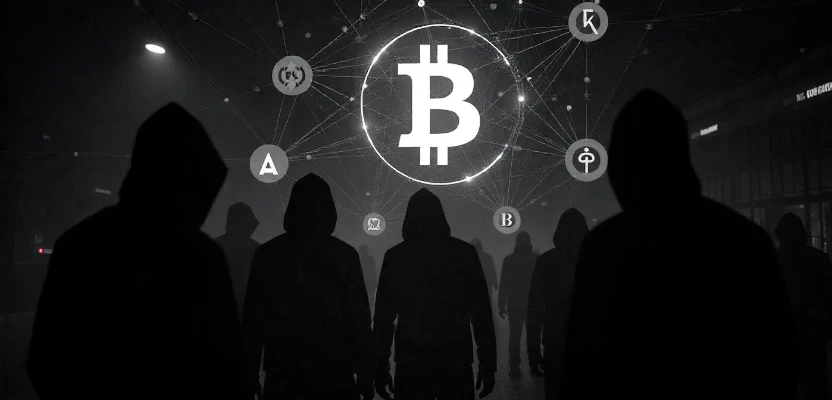
The Shift Back to Bitcoin
The evolving landscape of cryptocurrency usage within darknet marketplaces has once again shifted, with Bitcoin (BTC) reclaiming its position as the primary means of exchange. This resurgence follows the delisting of Monero (XMR), a privacy-focused cryptocurrency, from major exchanges, significantly impacting its accessibility and liquidity. According to a recent report by Chainalysis, a blockchain analytics firm, cybercriminals have increasingly turned back to Bitcoin due to the declining availability of privacy coins.
The Role of Monero in Darknet Transactions
For years, Monero had been the preferred cryptocurrency for illicit transactions on the darknet. Unlike Bitcoin, which operates on a transparent blockchain where all transactions can be traced, Monero offers enhanced privacy features, making it an attractive option for those seeking anonymity. Its ring signatures and stealth addresses obscure transaction details, providing a level of security that Bitcoin lacks.
However, this advantage began to wane when major cryptocurrency exchanges, including Binance and OKX, removed Monero and other privacy coins such as Dash (DASH) and ZCash (ZEC) from their listings. Binance, one of the largest global crypto exchanges, announced Monero’s delisting in February 2024, citing regulatory concerns and the need for compliance with financial monitoring standards.
Bitcoin’s Return to Prominence
Following the removal of Monero from mainstream exchanges, darknet marketplaces had little choice but to revert to Bitcoin for transactions. Eric Jardine, a cybercrime research lead at Chainalysis, noted a substantial increase in Bitcoin inflows into these marketplaces since Monero’s delisting.
“After major exchanges delisted XMR, we observed a significant shift back to Bitcoin. The reduced accessibility of Monero forced users to rely on a more liquid and widely accepted asset,” Jardine stated in an interview with CoinDesk.
Bitcoin’s appeal lies in its liquidity and broad market acceptance. Unlike Monero, which requires specialized knowledge and access to smaller, less reputable exchanges, Bitcoin remains widely available and can be easily converted to fiat currency. Although Bitcoin transactions are not inherently private, darknet users have found ways to enhance anonymity through coin mixing services and privacy-focused wallets.
The Scale of Illicit Crypto Transactions
Despite the renewed reliance on Bitcoin, illicit transactions remain a small fraction of overall cryptocurrency activity. According to Chainalysis data, only 0.14% of total crypto transactions—equivalent to approximately $50 billion—are linked to illegal activities.
While this figure may seem substantial, it is dwarfed by the total volume of cryptocurrency transactions worldwide. Additionally, stablecoins have increasingly become a medium for illicit payments, prompting issuers such as Tether and the Tron-led T3 Financial Crime Unit to take action. In a recent crackdown, the T3 unit froze over $100 million in illicit funds to combat financial crimes.
Law Enforcement’s Response to Darknet Markets
Law enforcement agencies continue to focus their efforts on darknet marketplaces, particularly those involved in the trade of illicit substances. One of the primary concerns is the sale of fentanyl, a potent synthetic opioid responsible for a global drug crisis. Markets that facilitate fentanyl transactions are at a significantly higher risk of being targeted by authorities.
Jardine emphasized that darknet markets operate with varying levels of sensitivity to fentanyl-related sales. Some marketplaces explicitly ban the trade of fentanyl, while others claim to prohibit it but fail to enforce the rule. Others may allow the sale of precursor chemicals rather than the final product, further complicating law enforcement efforts.
A recent high-profile case involved the shutdown of the Nemesis online marketplace. The U.S. Department of the Treasury’s Office of Foreign Assets Control (OFAC) cited the market’s involvement in fentanyl trafficking as the primary reason for its closure. As a result, OFAC sanctioned 44 Bitcoin addresses and five Monero wallets linked to the marketplace’s operator, Behrouz Parsarad.
The Future of Darknet Transactions
With Monero’s accessibility dwindling, Bitcoin is likely to remain the dominant cryptocurrency in darknet transactions for the foreseeable future. However, its use comes with challenges, particularly regarding traceability. Blockchain analysis firms and regulatory authorities are continually developing new methods to track and identify illicit transactions.
The crackdown on privacy coins suggests that regulators are increasingly targeting anonymity-enhancing technologies. While Bitcoin is far from being a perfect tool for criminals, its widespread adoption and ease of use make it a natural fallback in the absence of viable alternatives.
As the regulatory environment evolves, darknet operators and users may seek new strategies to maintain financial privacy. The rise of decentralized exchanges, privacy-enhancing Bitcoin protocols, and alternative privacy-focused cryptocurrencies could shape the next phase of darknet economy adaptations.
Conclusion
The darknet marketplace landscape is in constant flux, driven by regulatory changes, technological advancements, and enforcement actions. While Bitcoin has reclaimed its role as the dominant currency in these markets, its position remains tenuous due to increasing scrutiny from law enforcement and regulatory bodies.
As authorities continue to crack down on illicit crypto transactions, the methods and currencies used in darknet operations will likely evolve. Whether Bitcoin remains the cryptocurrency of choice for these activities or new, untraceable alternatives emerge, one thing is certain: the cat-and-mouse game between regulators and cybercriminals is far from over.




Comments 0